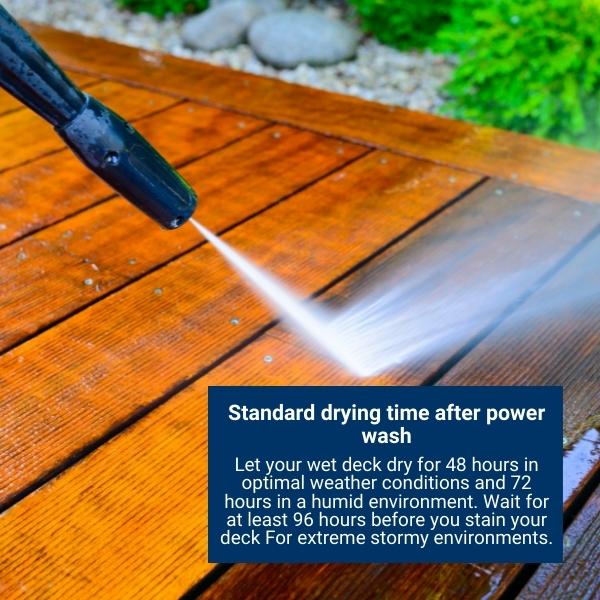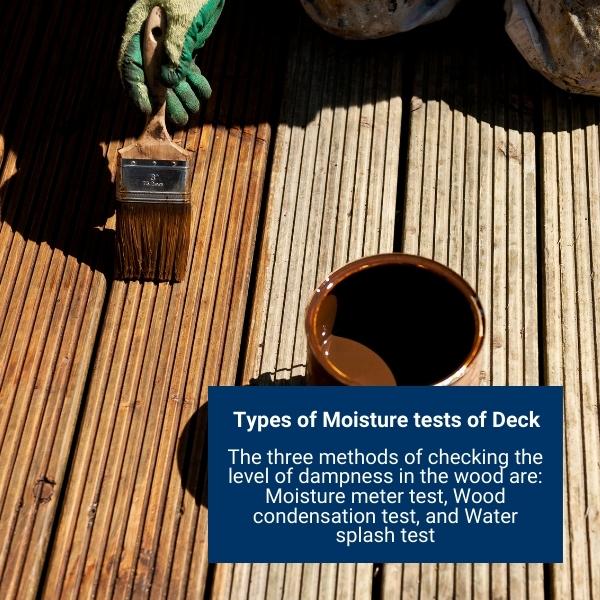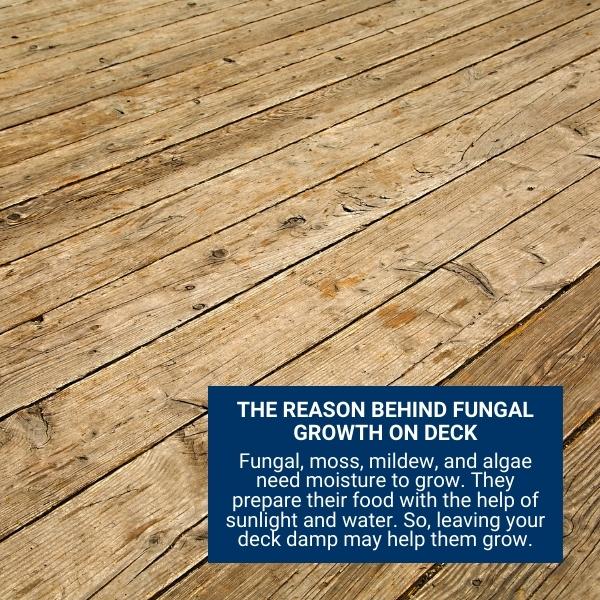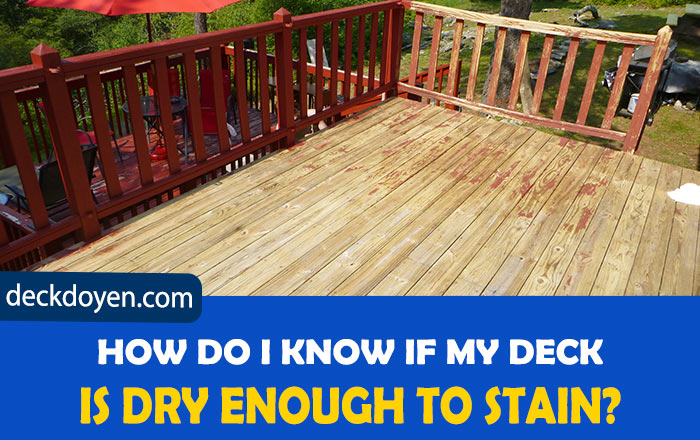Maintaining a deck is difficult. It needs regular washing, re-sealing, and coloring. Homeowners undertake these chores believing they are simple to do. So, if you are a DIYer finding the web for answers like “How do I know if my deck is dry enough to stain?” The answer is not easy and precise.
To check if your deck is ready to be stained, follow these three simple steps: 1) Use a moisture meter to measure the moisture content, ensuring it’s 19% or less. 2) Wrap the deck’s edge in a black trash bag, leave it in sunlight, and check for condensation inside the bag. If there’s condensation, the deck isn’t dry enough. 3) Sprinkle water on the deck; if it absorbs quickly, it’s ready for staining. If water beads up, the deck is still too damp.
For longer life of the deck, better results of staining, and saving extra cost of repair, you must check the dampness level of your wood planks. So, this article is to help all DIYers who want to stain their antique deck floor perfectly. I have authored everything you need to know before painting your deck. All methods are listed here, so you can avoid the causes leading to the moisture on the deck. Hence, reading it will help you paint your deck perfectly.
How Long Should I Wait For Staining After A Power Wash?
Your deck needs a suitable time to dry itself completely. If it doesn’t get enough time to dry, moisture will remain in your wood resulting in the growth of fungus, molds, and algae. Thus, destroying your wood. Therefore, you must wait for the minimum time before staining your deck.

After the power wash, allow your deck planks to dry for two days. That is the typical time frame for water evaporation after a power wash. Experts have standardized this time duration following appropriate drying conditions. The deck must face the sun, and the climate must be hot. Contrarily, If drying your deck in a shady place, you need to give it more time to dry. Three days may be enough to dry the wet deck. However, time projection depends on the day’s weather conditions.
Moreover, If there is a storm, you will need additional time. Soak the water above the deck surface before letting it dry naturally in the sun. Leaving water on a few areas of the wood planks makes them moister than the whole surface. You can also test the dampness on the surface with your foot to determine the amount of time required. Hence, the amount of time your wet deck will need to dry depends on the factors like temperature, air, and weather conditions. So, ensure that your power washes in a dry and hot environment. It will save a lot of your time.
Also Read: Best Decking Material For Winter: A Detailed Guide!
How Can You Check The Dampness Of The Wood Deck After A Power Wash?
You can’t stain your deck after just giving an optimal time to dry on its own. You need to check the dampness level of the wood, or you will seal the moisture in the wood and redo it. As will not only destroy the deck’s health but also cost you extra money. For instance, you left the dampness in your wood and coated it with a stain. The quick pealing and flaking of deck paint will cost you extra money for a redo. Furthermore, the early destruction of wood planks will require a replacement increasing the cost. So, it would be best to check your deck if it’s dry enough for staining. Here are a few methods for checking if there is moisture in your deck.

Three Methods To Check The Moisture Level Of The Deck After Power Wash.
1. Testing With Moisture Meter:
A moisture meter checking is one suitable approach to determine whether the deck is dry enough for staining. A moisture meter monitors the humidity of the wood. You need to check numerous places along the wooden platform for deck timber inspection through a moisture meter. A moisture content value of 19% or less is appropriate for staining.
2. Testing With A Bag Covering:
Another method for testing timber for the moisture is to place the edge in a black garbage bag and leave it in the sun for an hour or two. Open the polybag just four to five hours later. If you see condensation on the wood, it is not dry enough for staining. No, condensation means it is dry enough to stain.
Also Read: Deck Oil vs Stain, Which Is Best When And Where To Use?
3. Testing With Splashes Of Water:
To see if your wood is suitable for staining, you can try the third approach by splashing some water over it. The lumber is still too wet for staining or painting if the water beads form on the surface. However, If the water quickly absorbs into the deck planks, it is ready for staining.
Signs Indicate If Your Deck Is Dry Enough To Paint:
Check the wood visually to determine if the deck is dry on the surface before testing it. There should not be any puffiness or swelling in the wood planks. It would be best to avoid surface softness. Moreover, the color of wood also looks a shade darker when it has absorbed water. So, any swelling and coloration is the sign your wooden deck is wet. Hence, If watching it from your eyes does not satisfy you, give your wooden floor an extra day.
What Will Happen If You Attempt To Stain A Damp Deck?
If you stain a deck while it is still wet following pressure washing, the overall outcome will be different from your anticipations. Hence, you will not get the desirable results. Wood paints are often colors blended with oils that penetrate the wood. Therefore, the staining on damp deck planks will not result in adequate absorption, making your deck look uneven. So, here are the disadvantages of painting a wet deck.
Fungal Growth:
Microorganisms like fungi, algae, and mildews grow on any damp surface. When you color the wood without proper drying, you lock the absorbed water inside the wood. This water fulfills the need for water of moss, fungus, and algae for growth. Hence, the moisture sealing in the wood leads to unwanted moss, fungus, and mildew growths.
Also Read: Kreg Deck Jig vs Camo? Which One To Use and Where?

Flaking:
Moreover, If you stain a wet deck after pressure-treating the wood, it will not cling perfectly to the substrate. Moreover, staining the wet wooden deck will cause your stain to fracture and remove in the form of flakes. Hence, you will require to redo the entire task of painting shortly. Therefore, it would be best to air dry before coloring it to avoid the stain peeling. Staining your wood not only preserves the deck but also improves its appearance.
Self Deterioration Of Wood:
Staining a wet wood will likely decay it from the inside because moisture is left within. Some wood begins to deteriorate more quickly than others due to absorbed water in the pores and spaces between deck planks. The exposure to sun and other climate conditions makes the deck maintenance hard after washing. Wood is prone to slow decay as long as it holds moisture because it collects water and freezes as the weather changes. The freezing result in cracks, damaging the wood.
Less Durability:
When your floor is damp, the layer of deck paint remains thin. Wood doesn’t absorb the oils in the stain because the water has filled the pores of the deck wood. Hence, the extreme weather conditions and inside moisture result in a thin coat of deck stain. It results in instability and less durability of deck paint, and it will start flaking early. Thin layers of paint also provide less UV protection. So, if you want lasting protection of deck wood, let it dry for some time.
Color Fading:
Due to the application of thin layers of stain over wood, the UV rays from the sun start affecting the shade of the deck paint resulting in its fading. Since your wood planks were damp, the pigments of staining liquid did not absorb in the woods. Therefore, it started to fade due to harmful UV rays of the sun and extreme climatic effects.
Also Read: How Can You Build a Deck Without Concrete? Step by Step Guide

When Is The Best Time To Stain A Deck?
You should stain your new deck soon after the installation without wasting time. This way, dust, and filth have less time to form on the wood. You may also want it as clean and dry as possible for a long time. So first, check the weather forecast to ensure that It’s not going to rain within a week and you have dry weather. Aim for temperatures that are dry and hot (but not scorching). You want anything between 50°F and 90°F. Increased humidity will slow the drying of your wet deck and stains.
In short, it should not be too chilly or too warm. A dry, warm day is the ideal climate condition for staining a deck area is a perfect choice. There should be no wind or humidity. The sun’s heat should range from 10° to 35° Celsius. You don’t want to stain the decking while the sun is hotly above the earth. Since the stain will dry too rapidly, the wood will not be able to absorb it.
However, You should not stain pressure-treated wood soon after installation since the chemicals that protect the wood from insects and moisture also restrict optimum stain or paint infiltration. Wait at least 42-50 days if the wood has light exposure. Wait 28 weeks if it is in the shelter. Wait 18one and a half years following the installation before washing, sanding the wood, and applying an oil-based penetrating stain for the best effects.
Also Read: How to Prepare the Ground Under Deck in 7 Steps?

Conclusion:
Staining is essential for deck maintenance and keeping it in good condition for years. However, staining it in the wrong way may deteriorate the health of your deck wood and cost you more money than required. Therefore, you must test your deck for moisture in either of the three ways that I have listed in this article. Not measuring the dampness will result in undesirable outcomes after staining the deck. It will also result in causing more harm to your floor than good. In a nutshell, staining a deck is not straightforward. It needs care. The proper drying, accurate weather condition, and good quality stain can give your floor an esthetic appearance.
Also Read: Should A Deck Be Level Or Sloped? Detailed Answer!
FAQs
What Happens If You Do Not Allow The Wood To Cure Before Staining It?
Wood expands and contracts as it absorbs and expels moisture. It implies that dealing with wet wood distorts, get oils less efficiently, fracture, and change forms. It may also result in fungal and moss growth.
What If You Stain Your Deck, And Then It Rains?
If it rains within 48 hours of applying the stain, the water will sink into the pores of the board and attempt to dislodge the dye. If the clouds pour after you stain the deck immediately, it will peel and flake off. It may not occur if your paint has been curing for more than 48 hours.
Why Do We Have To Scrape The Previous Stain Before Staining Again?
The color of the previous stain can change the shade of the new paint. If it has already peeled off from some places, your deck will look shady after the staining. That’s why It would be best to scrape the layers of the previous stain before applying again for better results.
How Can I Remove Algae Growth From My Deck?
You have several alternatives for eradicating algae from your hardwood deck. The most popular is bleach, but bleaching your deck may change its color and possibly damage the metal bolts that hold your deck together. Therefore, the occupational Safety and Health Administration does not suggest bleach for algae and mold eradication. However, you can use white distilled vinegar. It is a popular natural cleanser that is suitable for indoors and outdoors. To eliminate algae, mold, and mildew, mix one gallon of water with one glass of white vinegar and scrape the floor with the solutions.

